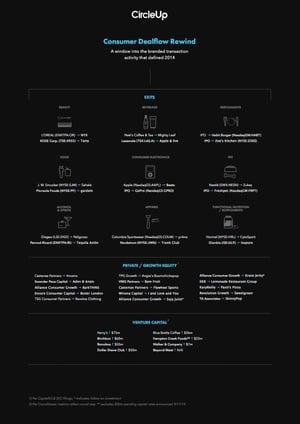 By: Zach Grannis
By: Zach Grannis
At CircleUp, we find investment opportunity in early stage, high growth consumer brands. A core tenet of this thesis is the underpinnings of healthy exit environment – the dynamics of which remain vibrant as ever from our vantage.
As we enter the last two weeks of 2014, we took some time to reflect on what appeared to be a marquee year for many branded consumer companies (as well as their financial backers). Amidst the backdrop of a global resurgence in M&A, coupled with the strength in public capital markets and a low interest rate environment, the branded consumer category not only kept up this year, it thrived.

The graphic above demonstrates a snapshot of what we found interesting in 2014. Whether it be the largest consumer electronics IPO in nearly a quarter century, GoPro, the first and only natural/organic pure play take-private, Annie’s, or the series of $50 million plus venture capital financings, activity levels in the sub-verticals of relevance to CircleUp definitely did not disappoint.
There was no shortage of headline strategic M&A. And it was interesting to see category dominant strategics like L’Oreal and Smucker’s reach below conventional thresholds to acquire sub $100 million in sales brands like NYX and Sahale, respectively. In the case of NYX Cosmetics, where industry sources estimate that L’Oréal may have paid nearly $500 million for the mass-market cosmetics brand, it appears that buyers are willing to pay significant premiums in order gain exposure to growth that diversifies their brand portfolios.
Where the innovative persists, we expect to continue to see strategic appetite at earlier stage levels at least in part due to the following:
- Conglomerates struggle to innovate through massive infrastructural constraint;
- Authenticity, storytelling and product passion from founders via social marketing is now driving purchase behavior; and
- Disjointed, and often times fragmented, consumer preferences from “taste-making” millennials are not being adequately satisfied by legacy product offerings.
Being a millennial myself, I can attest to third point. For example, where my parents and grandparents historically reached for labels like Kellogg, SC Johnson, etc. as a measure of safety and trust, my generation on the other hand, is rather skeptical of these large organizations. Today’s consumer not only cares about the ingredients on the back of the label, but also takes time to understand where the ingredients are sourced, the manner in which product is produced, how the brand contributes to its community and the overall environmental impact.
Whether it’s a craft beer, a $5 cup of fair-trade coffee or a bag of kale chips, these shifting consumer tastes provide windows of both opportunity and anguish for legacy brands. The question is which side of that equation will the category dominant participants choose to end up on. And to the extent they decide to make a move—will they execute at the right time.
What we’ve seen in 2014 is that playing the waiting game can prove quite costly, exemplified by Coke’s minority acquisition of Monster after launching what seemed like a half dozen failed attempts to create competitive offerings over the years. General Mills must have also had at least a couple chances to buy Annie’s in a pre-IPO capacity that would certainly have cost less than the $820 million price tag it swallowed just two months ago. (In all fairness, there are specific aspects to every deal that go unbeknownst to the public and it is critical to remember that the price paid in a strategic transaction is not necessarily reflective of underlying value of a brand but rather, the value of that brand to a specific acquirer.)
Strategic interest is not the only path to exit for an early stage investor and 2014 demonstrated its fair share of branded consumer IPO’s. 13 in fact,including two in the fast casual restaurant category, perhaps most notable due to the fact each concept had just about 100 units which is fairly early stage relative to historical precedent. There was also meaningful private equity interest in the category, which we believe will continue to be a critically important building block for many brands on their way to a strategic exit or IPO. One common theme for 2014 sponsor-backed investment and M&A was that many considered it a seller’s market – mostly a result of the growth in the amount of capital on the sidelines which, along with outpacing the amount of dealflow, created more competitive processes and thus higher valuations. And less we forget the continued access to cheap leverage that allowed sponsors to be more creative in structuring transactions.
Last but not least, the convergence of consumer and technology continues to change the way we think about manufacturing and distribution, and the interaction we have with the brands we love. Where disruption exists, venture capital is close by and the consumer-tech space is no exception. The eight brands highlighted above raised over $300 million in aggregate this year and that excludes the undisclosed size of Beyond Meat’s Series D financing that closed over the summer. Nordstrom’s acquisition of Trunk Club is just one example of how venture capital can accelerate the path to a multi-hundred million dollar exit in just five years’ time.
A reflection on 2014 re-affirms our excitement around the consumer category – not only with the transactions of the past, but for the next wave of marquee activity. At CircleUp, we’re excited to cement an important stepping stone in the fundraising life cycle and are committed to helping entrepreneurs thrive by giving them access to the capital and resources they need to grow.
ABOUT THE AUTHOR:
Zach has spent his professional career advising brands that operate across all the major sub-verticals of consumer. Prior to joining CircleUp, Zach worked as an associate in Piper Jaffray’s consumer investment banking group where he focused on providing various capital raising and M&A advisory services for both private and public companies.
